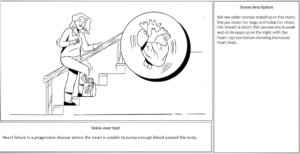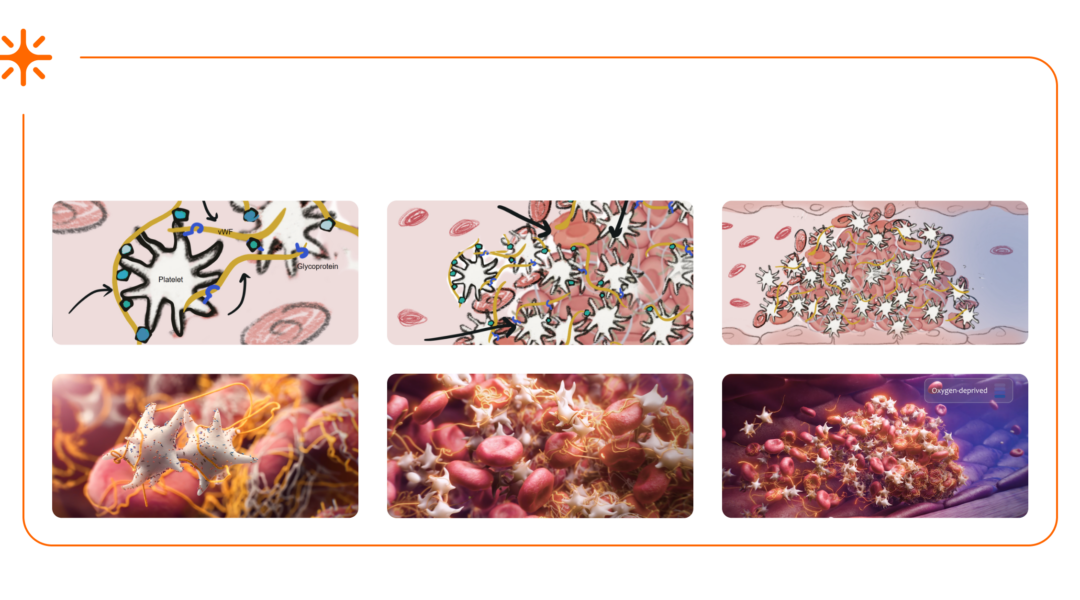A storyboard is the foundation of any animation.
It’s the first step in planning the animation’s appearance and how it will work.
Why storyboarding matters becomes apparent when you try to animate science without it.
That’s when you risk losing key details, confusing your audience, and wasting time fixing things late.
Let’s break it down.
What Is a Storyboard?
A storyboard is a series of rough sketches with notes.
It shows what each scene will look like and what’s happening.
Before any design or animation begins, we plan everything in the storyboard.
We define what we show, how elements move, and where the camera goes.
This step takes time.
Sometimes as much time as the design and animation itself.
But that’s why storyboarding matters—it sets the entire animation on the right path.

Why storyboarding matters: This scene shows an older woman struggling to breathe on the stairs. Used in the alfapump animation to highlight symptoms.
Why Storyboarding Matters for Science Animation
Without a proper storyboard:
-
Key scientific details may be left out.
-
The message may not be clear to your audience.
-
Revisions later in the process become expensive and time-consuming.
A clear storyboard helps you:
-
Align with your team
-
Avoid misunderstandings
-
Spot problems early
-
Make sure the science is correct
Why storyboarding matters most in life science animation is because it gives you a chance to review the story before animation starts.
Once production begins, changing direction’s harder (and more expensive).
Keep the Storyboard Rough (and Focused)
We believe a storyboard should stay rough.
Not polished. Not detailed. Just clear.
If the images are too refined, the focus shifts to how it looks—
instead of what it shows.
In this early step, content matters more than style.
We want you to think about the story, not the visuals yet.
That comes later.
What’s Included in a Storyboard?
We define:
-
What elements will appear on screen
-
How big they are in relation to each other
-
How they move
-
How they interact
We also write short, precise descriptions for each scene.
This helps explain what’s happening and why it matters scientifically.
Storyboarding matters in science animation because it forces clarity before a single frame is animated.
Real Example for Why Storyboarding Matters: Basking Biosciences
Our animation for Basking Biosciences started with sketches and written notes.
Each note explained what to show and how to show it.
Example instructions from the storyboard:
From now on, we will show the clot formation in a close-up view with more details.
Various proteins (represented as random blobs of different colors) are on the surface of the platelets.
The most important protein is glycoprotein, which we suggest depicting more realistically—shaped like a hook.
The von Willebrand Factor (vWF) strings bind to these proteins, and platelets adhere via these vWF strings.
As the camera zooms out, we see red blood cells, platelets, fibrin, and more vWF.
The clot appears dense at the core, loose around the edges. A bluish hue suggests low oxygen.
A narrow opening allows a few red blood cells to squeeze through.
Because all these details were mapped in the storyboard.
Everyone understood what the scene needed to communicate before the animation started.
That’s why storyboarding matters. It saves time, avoids rework, and improves the result.
The Result: Better Science Animation
When you work with complex science, details matter.
If they’re not planned early, they’re hard to fix later.
A precise storyboard:
-
Reduces back-and-forth
-
Speeds up production
-
Keeps your science accurate
-
Leads to a better final animation
This is why storyboarding matters so much in biotech and life science communication.
It’s not just a step. It’s the step that makes everything else work.
Final Thoughts
If you’re creating a science animation, don’t skip the storyboard.
It’s the most innovative way to save time, money, and effort while ensuring your message is crystal clear.
Learn more about our process on the main page.

